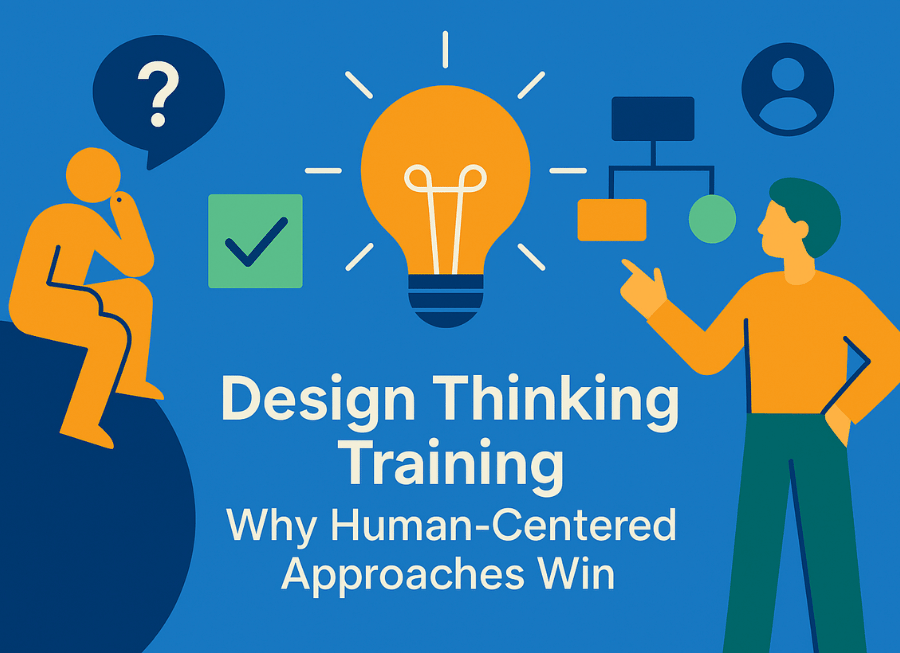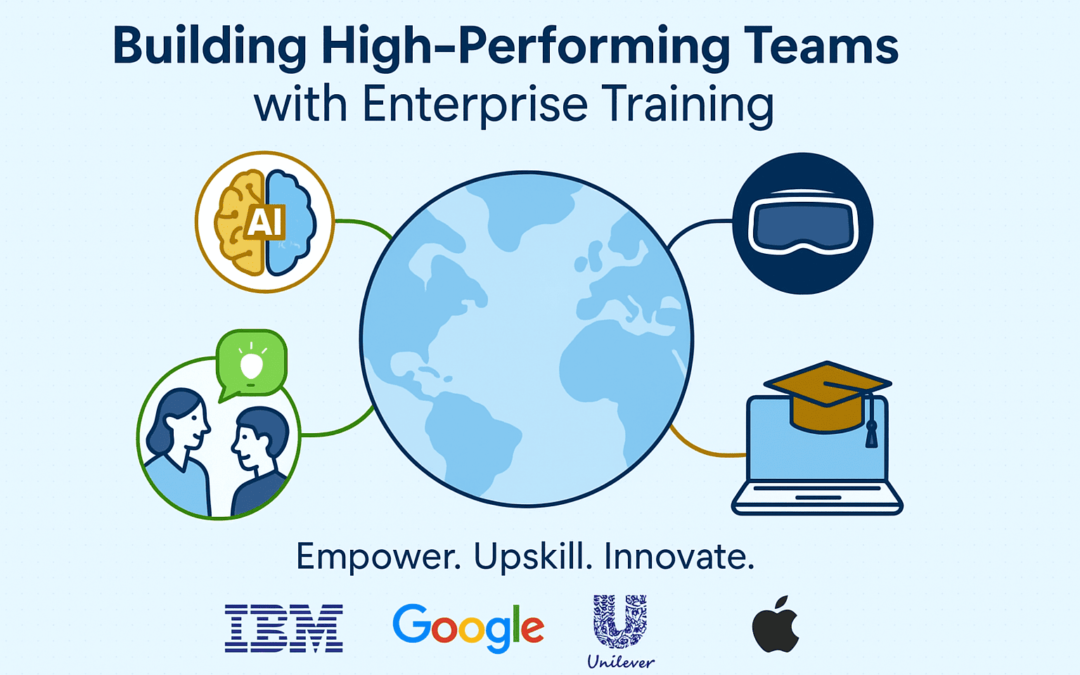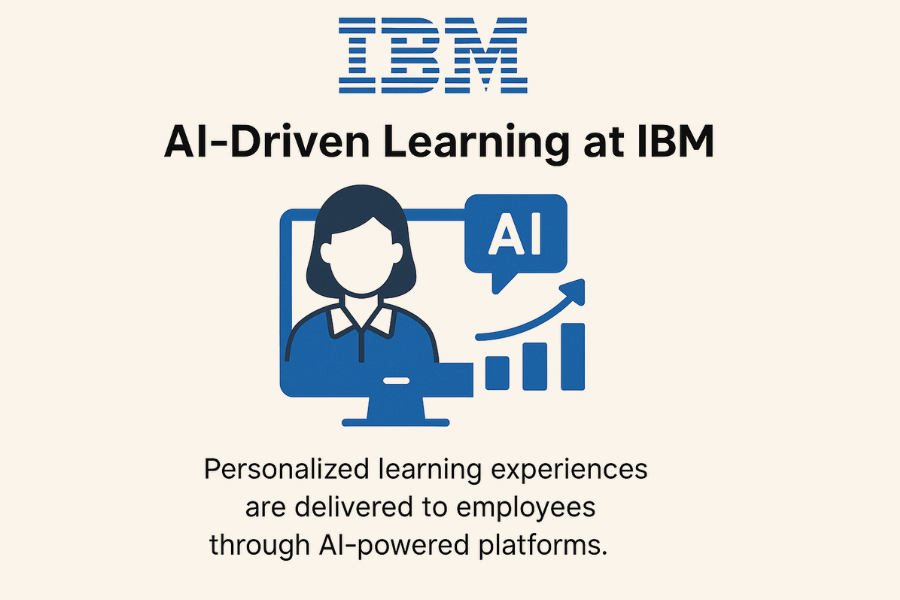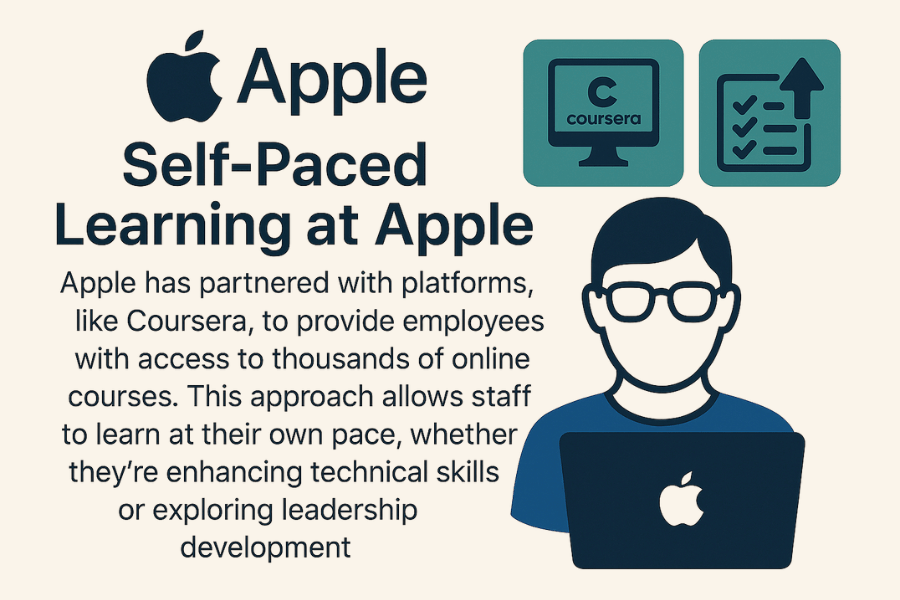
by Rochelle Tan | May 20, 2025 | Blog
You’ve spent weeks, months, maybe even years building a system, solution, or service you knew would be a game-changer. Then comes the shock: it flops.
Customers aren’t buying-in. Subscribers are leaving in droves. The feedback is full of complaints. And to top it off, your competition rolled out something better months ago.
The team is left scratching their heads, asking, “What went wrong? What did we miss?”
Unfortunately, this scenario is all too common. We pour time, money, and resources into creating something, only to overlook the most important factor: the people using it.
That’s where a human-centered approach comes in—and it’s made possible through design thinking.
Design thinking isn’t just a buzzword; it’s a must-have for businesses that want to create innovative, customer-focused solutions. With the right training, your team can develop strategies that truly connect with users and deliver products that leave a lasting impact. Ready to rethink how you create? Let’s get started.
Explore Our Training Offerings Browse Our Design Thinking Workshops
Innovation is moving faster than ever, and businesses need to do more than just “build” solutions to keep up. The best companies stand out because they truly understand their customers and create products or services that connect on a deeper level. That’s where design thinking comes in—a simple, human-centered method that puts people first.
Design thinking helps businesses succeed by building real empathy for customers, encouraging teamwork, and sparking practical, creative ideas. But how can companies embrace this approach? It starts with the right training. Teaching teams how to think this way creates a mindset shift, helping businesses solve real customer problems, while delivering value again and again. Design thinking isn’t just a process—it’s the key to creating products and services that truly matter.
What is Design Thinking?
At its core, design thinking is a human-centered problem-solving methodology that helps teams tackle challenges creatively and collaboratively. This iterative process focuses on understanding user needs and connecting these insights with solutions that are desirable, viable, and feasible.

Figure 1.0 Double Diamond from www.designcouncil.org.uk
The five key principles of design thinking are:
- Empathy: Understand the users’ emotions, challenges, and needs.
- Define: Accurately articulate the problem that needs solving.
- Ideation: Brainstorm a range of possible solutions.
- Prototyping: Build early models of the solutions for validation.
- Testing: Use feedback to iterate and refine the product or service.
Unlike traditional problem-solving methods, design thinking promotes divergent and convergent thinking, enabling teams to explore multiple possibilities before converging on the best solution. For example, in developing a new app, a team might first deeply study the challenges faced by users, brainstorm dozens of features, prototype several variations, test with real users, and ultimately launch a refined version. This approach creates products that are inherently customer-obsessed.
The Power of Human-Centered Design
Human-centered design, as the name suggests, puts people first. It’s not just about creating solutions but also ensuring these solutions improve people’s experiences and create measurable value.
How does it transform organizations?
- Enhances Customer Experience: Businesses deliver solutions that truly resonate with users by ensuring the customer is at the heart of every decision.
- Promotes Better Product Development: Teams test ideas against real-world scenarios, ensuring outcomes meet user expectations.
- Encourages Collaboration: By involving stakeholders from diverse functions, organizations capitalize on different perspectives to ensure robust solutions.
Take the example of IDEO, a pioneer of human-centered design thinking. IDEO redesigned a hospital admission process by walking in the shoes of patients, uncovering pain points, such as long wait times. Their new solution optimized patient experiences seamlessly, while maintaining hospital efficiency.
Why Companies Need Design Thinking Training
Transitioning to a design thinking mindset isn’t a natural shift for most organizations. Many still operate on the “build-it-and-they-will-come” philosophy, which can lead to wasted resources and products that fail to meet user needs.
Here’s why design thinking training is essential for businesses looking to innovate sustainably:
- Creates a common language: Training creates a unified language and approach to innovation, helping everyone collaborate effectively, align on goals, and focus on customer-centric solutions. This shared vocabulary improves communication and ensures consistency in tackling challenges across the organization.
- Fosters a Customer-Obsessed Culture: Training helps teams internalize the importance of viewing every problem through the lens of customers, resulting in better-aligning business goals with customer needs.
- Overcome Challenges of Mindset Shifts: Moving from strictly solution-oriented thinking to an iterative process requires guidance and practice. Training eases this transition.
- Equips Teams with Actionable Skills: From conducting empathy-driven research to running effective ideation sessions, training introduces teams to hands-on techniques they can implement every day.
For businesses aiming to create innovative solutions and strengthen long-term competitiveness, investing in design thinking training is non-negotiable.
How to Implement Design Thinking Training in Your Organization
Introducing design thinking into your organization can seem daunting at first, but a structured approach can smooth the way for adoption. Here are five actionable steps to roll out an efficient training program:
- Assess Your Needs
Begin with your organization’s goals and challenges. Conduct an honest assessment by asking yourself these questions: Do you need to improve product innovation? Strengthen the customer experience? Develop a roadmap to identify which teams would benefit most from training.
- Define the Right Training Structure
Choose training formats that address your organization’s needs, such as:
• Workshops for hands-on, immersive learning.
• Online Courses for flexibility and scalability.
• Custom Programs tailored to your organization, directly addressing unique challenges.
- Conduct Pilot Programs
Roll out a small-scale training program to identify pain points before wider implementation.
- Integrate Training within Workflow
Designate design thinking champions and ensure practices are incorporated into regular team processes, such as product road mapping and sprint planning.
- Measure the Impact
Use metrics to monitor training effectiveness, such as improved customer satisfaction scores, increased product success rates, or employee retention.
Best Practice: Tie training outcomes to measurable results to ensure strong leadership buy-in.
Common Pitfalls and How to Overcome Them
Implementing design thinking training can come with its fair share of obstacles. Here are some common challenges and strategies to address them:
- Resistance to Change
Employees may resist adopting the iterative design thinking process. To overcome this, start with smaller projects and celebrate quick wins. Share success stories to demonstrate the tangible benefits of the approach.
- Misconceptions About Design Thinking
Many believe design thinking is just for designers. Break this misconception by showcasing its application across various functions, from HR to product development.
- Leadership Hesitation
Securing leadership buy-in is critical. Anchor your discussions with data showing how successful design thinking improves outcomes and saves long-term resources.
Conclusion & Call to Action
The power of human-centered design lies in its ability to revolutionize businesses by aligning solutions with real customer needs, fostering innovation, and improving collaboration. Design thinking training doesn’t just teach a methodology; it ignites a mindset shift that empowers teams to work smarter and deliver greater value consistently.
If your organization is ready to take its products and services to new heights, now is the time to bring design thinking training into your teams.
Browse Our Design Thinking Workshops
About the author
As an Agile Evangelist, Rochelle Tan has over 20+ years of experience in agile transformation with small to large organizations from various industries in North America and Asia: Oil and Gas, IT, Healthcare, Finance, Insurance, and Government.

by Rochelle Tan | Apr 28, 2025 | Blog
How do Fortune 500 companies continuously nurture innovation, drive efficiency, and maintain their competitive edge? The answer lies in a focused investment in enterprise training programs that empower their workforce. Developing high-performing teams isn’t just about hiring the right talent; it’s about equipping them with the skills and tools necessary to thrive in an evolving business landscape.
This article explores how companies, like Google, Unilever, Apple, and IBM, are using tools like AI platforms, VR simulations, and personalized coaching to enhance enterprise training and measure its long-term impact.
Why Enterprise Training Matters
Enterprise training is no longer a ‘nice-to-have’; it has become a critical strategic priority. With industries constantly adapting to emerging technologies and shifting consumer preferences, businesses can’t rely solely on the skills employees brought on their first day. Continuous learning ensures that teams remain future-ready, productive, and motivated.
Key Benefits of Enterprise Training:
- Skill Enhancement: Keeps employees up-to-date with technological advancements.
- Productivity Gains: Reduces errors, streamlines processes, and encourages innovation.
- Improved Employee Retention: Employees who feel supported in their career development are more likely to stay.
- Enhanced Collaboration: Training builds cross-functional knowledge, enabling seamless collaboration among diverse teams.
How Fortune 500 Companies Do It
Fortune 500 companies have taken enterprise training to new heights by adopting advanced technologies and groundbreaking methods. Here’s a look at how some of them are leading the way:
Ai-Driven Learning at IBM
IBM has long been a believer in continuous learning and growth as a way to promote employee retention. The company has pioneered the use of AI-powered platforms, like their AI Academy, to deliver personalized learning experiences to employees globally. These platforms analyze individual learning styles, career goals, and skill gaps to recommend tailored courses.

AI also powers IBM’s efforts in identifying and addressing future skills gaps. By using tools, like AI-driven analytics, IBM can predict which areas require upskilling and deliver highly relevant content to employees. The result? Teams equipped with the latest technological knowledge, prepared to tackle emerging challenges.
Employee-to-Employee Learning at Google
Google’s employee-to-employee learning programs are a testament to the power of shared knowledge.

This unique approach has employees teaching their peers, creating a culture of collaboration and continuous learning. The emphasis on internal expertise allows Google to quickly address skill gaps while fostering a deeper sense of community and engagement.
VR Simulations at Unilever
Practical skills that require real-world applications can benefit immensely from virtual reality training. Unilever has implemented VR simulations in various areas, from factory management to leadership development. These simulations enable employees to practice decision-making and problem-solving in risk-free, controlled environments.

For instance, HR professionals at Unilever use VR to master handling sensitive workplace interactions, while supply chain managers practice optimizing logistics. By incorporating immersive learning experiences, Unilever enables employees to gain confidence before executing tasks in the real world.
Self-Paced Learning at Apple
Apple has partnered with platforms, like Coursera, to provide employees with access to thousands of online courses.

This approach allows staff to learn at their own pace, whether they’re enhancing technical skills or exploring leadership development. Through this method, Apple fosters a self-driven learning culture that empowers employees to take charge of their growth trajectories.
Measuring ROI on Enterprise Training
Investing in enterprise training programs is a significant financial decision, and ensuring a measurable ROI is essential. Here are key metrics and tools to evaluate training effectiveness and long term impact:
Productivity Metrics
Analyze KPIs, such as output quality, problem-solving efficiency, and innovation rates, before and after training initiatives. Have teams been able to implement what they’ve learned to reduce costs or improve speed? Has there been a reduction in errors or an increase in productivity? These metrics can help determine the impact of training on individual and team performance. An example of these KPI’s are as follows: is the flow metrics
Employee Assessment
Use customizable AI-assessment models, like the AI Maturity Index, to capture a baseline of the organization’s current capabilities and track improvements driven by new training efforts. Such tools measure employee skills, engagement, and sentiment towards their roles and the organization. This process provides insights into how training drives knowledge, improves quality, and fosters innovation within the enterprise.
Business Impact Analytics
Monitor revenue growth, customer satisfaction, or operational savings linked to specific skill advancements. For instance, Unilever has linked its VR simulations to improvements in manufacturing efficiency and decision-making speed.
Ensuring Long-Term Success with Continuous Learning
Sustainable training programs are not one-off initiatives. Companies, like Google and IBM, have demonstrated that fostering a culture of continuous learning is vital for long-term success.
Here’s how organizations can build such an environment:
-
- Encourage Knowledge Sharing: Implement peer-to-peer learning models like Google’s.
- Adopt Flexible Training Formats: Combine self-paced studies (like Apple does via Coursera) with interactive methods such as VR or in-person workshops.
- Leverage Advanced Tools: Use AI to personalize content and forecast future training needs.
- Commit to Leadership Development: Offer coaching programs that prepare future leaders for complex business challenges.
The Cutting Edge of Enterprise Training
Enterprise training powered by technology is transforming how organizations develop talent across industries. From IBM’s AI-driven personalized learning to Unilever’s immersive VR simulations, these initiatives equip employees to handle modern business challenges with confidence.
The benefits are undeniable: companies that innovate in learning and development experience improved performance, greater adaptability, and stronger teams across all functions. By fostering continuous growth, providing essential skills, and using data to refine training strategies, businesses build agile, high-performing teams ready to excel in an ever-changing landscape.
To maximize these outcomes, it’s essential to integrate expert guidance alongside advanced training tools. Partnering with external specialists, like RTculate, leaders in business coaching and enterprise development, can significantly enhance your organization’s training programs. Their tailored coaching solutions elevate team capabilities, ensuring employees are not only prepared but empowered to thrive.
Curious how to take your enterprise training to the next level? Explore how RTculate’s expert coaching, scalable learning platforms, and professional upskilling opportunities can empower your workforce, keeping your organization ahead of the curve today.
Additional Information for Professional Learners
For individuals and teams looking to deepen their technical expertise, RTculate and Ateneo De Davao – ALL AI Fundamentals: Pioneering GenAI for All course. This self-paced program provides employees with essential knowledge of AI technologies, helping them stay ahead in today’s tech-driven world. Incorporating such resources into your training strategy ensures a well-rounded approach that addresses both organizational and individual growth.

About the author
As an Agile Evangelist, Rochelle Tan has over 20+ years of experience in agile transformation with small to large organizations from various industries in North America and Asia: Oil and Gas, IT, Healthcare, Finance, Insurance, and Government.

by Rochelle Tan | Apr 22, 2025 | Blog
Emily, a manager at a growing tech firm, starts her day with coffee and a holographic Artificial intelligence (AI) dashboard. Real-time visuals show team performance, project delays, and predictive analytics for resource bottlenecks. AI handles her admin tasks—drafting emails, scheduling across time zones, and adjusting staffing plans. During brainstorming, AI turns ideas into 3D prototypes for instant sharing. By afternoon, it alerts her to a competitor’s move with actionable strategies. For Emily, AI makes leadership fast, visual, and efficient.
The story above is just a glimpse of how the application of AI solutions can streamline work for various people in the organization. This is no longer a futuristic concept reserved for our imagination. Today, AI has swiftly transformed into a game-changer for businesses globally, reshaping how work is approached, completed, and managed. For CEOs, HR professionals, and tech leaders, this evolution presents an opportunity to rethink workforce strategies, balance human capital with AI, and redefine leadership in the era of automation.
This blog explores how AI is transforming hiring, upskilling, and leadership training, the rise of AI-augmented employees, and strategies Fortune 50 leaders are deploying to create harmony between AI and human talent.
AI in the Workforce: Productivity, Innovation, and Skill Development
AI is revolutionizing various business operations. From automating mundane tasks to sparking creativity, its impact is felt across industries.
Enhancing Productivity with AI
AI enables professionals to focus on high-value tasks by automating repetitive and time-consuming processes, such as generating real-time project status reports or assembling datasets for decision-making. According to a survey conducted by Pryon and Unisphere Research, 70% of respondents reported that the average professional will spend one hour or more looking for a single piece of information — with nearly a quarter (23%) spending more than five hours. Drawing from this result, an average employee spends over three hours daily searching for information. With AI tools, this wasted time can be reduced significantly, leading to a marked boost in productivity.
Real-World Example:
Microsoft Copilot, an AI-powered assistant, is transforming meetings by summarizing key points and identifying action items for teams. While there have been challenges, such as capturing trivial actions, it demonstrates how AI can streamline day-to-day operations for better outcomes.
Alleviating Grunt Work
AI systems are designed to handle repetitive, rule-based tasks, which frees employees to focus on strategic and creative responsibilities. For instance, HR departments leverage AI to screen resumes, while marketing teams rely on AI for content optimization and lead scoring.
Recruitment and hiring Example:
LinkedIn is leveraging AI to help recruiters be more effective by having more time assessing the candidates by getting to know them and convincing them to join the organization instead of being buried in tedious work – setting up meetings, clarifying requirements from hiring managers, and doing initial job screening.
AI for Upskilling and Personal Growth
Learning new skills in today’s fast-paced environment can feel overwhelming. Enter AI-powered learning assistants! These tools offer personalized recommendations and step-by-step guidance, enabling professionals to upskill faster and more effectively.
Text Creation Example:
AI platforms, like Jasper, are revolutionizing content creation by streamlining the process and improving results. Jasper not only helps writers craft persuasive copy, but also serves as an educational tool, teaching users how to write more effectively for SEO. As a content creator, I have personally found Jasper invaluable. While I often have great ideas to share, I sometimes struggle with narrowing my thoughts and organizing them into a cohesive, logical flow. Jasper helps me overcome these challenges, making it one of the key tools I rely on to produce more compelling and relevant content.
Driving Innovation and Creativity
AI doesn’t just do what humans can do faster; it also unlocks entirely new ideas. By leveraging AI’s analytical power and pattern recognition, organizations can innovate in ways previously unimaginable.
Advertising asset Example:
OpenAI tools like DALL-E let creative teams quickly generate images from text, making it easier to produce advertising assets faster and more affordably. It saves time and reduces costs by providing a convenient tool for creating content without the need for a large design team.
Transforming Leadership with AI
Redefining the workforce is about more than just tools. It’s also about leadership. With AI augmenting employees, CEOs and other organizational leaders must adapt to manage AI-human hybrid teams better.
The Rise of AI-Augmented Employees
AI has given rise to a new type of worker who is not fully human but works alongside human teammates. For example, AI email automation prioritizes customer communication, while chatbots take care of frontline interactions. These AI-augmented employees extend the capacity of human teams and ensure a seamless business operation.
Leadership Training and Adaptability
AI is reshaping leadership training by providing data-driven insights into management styles, employee engagement, and team dynamics. Real-time feedback systems allow executives to refine their approach to fit organizational needs.
Strategy for CEOs to Harmonize AI and Human Talent
Fortune 50 companies are employing several strategies to integrate AI without losing sight of the human element. This includes ensuring transparency around AI initiatives, investing in employee training, and maintaining oversight to prevent over-reliance on AI decision-making.
Key Steps for Leaders to Adapt and Thrive
- Impart AI Literacy: Ensure teams across all levels understand how to use AI tools effectively.
- Invest in Collaboration Training: AI’s potential is maximized when it complements human ingenuity. Leaders must emphasize tools that foster collaboration rather than isolate departments.
- Build Trust in AI: Transparency about how AI works and its limitations is crucial for fostering trust within teams.
Real-Life Case Study
Here’s a real-life use case of how RTculate, a boutique consulting company, has leveraged technology to create an effective AI training course to promote consistency and sustainability.
Problem: Creating high-quality narration for the AI Fundamentals course was a challenge. Hiring a human narrator would have been time-consuming, expensive, and less sustainable, with added logistical issues for future updates.
Solution: RTculate turned to WellSaid’s AI voiceover technology, which offered a streamlined, efficient, and cost-effective way to produce professional-grade narration. The AI solution allowed for fine-tuning specific pronunciations and provided the flexibility to adapt to various English accents and languages.
Outcome: The AI voiceover not only delivered exceptional quality, but also ensured long-term flexibility for course updates without the need to coordinate with a human narrator. This approach saved time, reduced costs, and aligned with RTculate’s commitment to sustainability, while maintaining top-tier results.
Winning the Future with AI
The benefits of AI are impossible to ignore. It amplifies productivity, fuels creativity, reduces operational burdens, and drives unparalleled insights. The human-AI partnerships we forge today will undoubtedly define the competitive landscape of tomorrow.
If you’re ready to explore the potential of AI in your organization, start small. Identify specific processes where it can make the biggest impact, experiment with tools, and scale as you gain confidence. AI is not here to replace jobs; it’s here to redefine them. Seize the opportunity to lead this transformation.
RTculate has partnered with Ateneo de Davao Academy Lifelong Learning department to provide professionals an interactive and informative course on AI Fundamental: Pioneering GenAI for All.
About the Author
As an Agile Evangelist, Rochelle Tan has over 20+ years of experience in agile transformation with small to large organizations from various industries in North America and Asia: Oil and Gas, IT, Healthcare, Finance, Insurance, and Government.

by Rochelle Tan | Sep 20, 2024 | Blog
Is your organization struggling to consistently deliver products and services? Does bureaucracy impede your decision-making process? Are you encountering obstacles in getting things done? Are these questions too close to home? Then, it may be time to reassess and rejuvenate your ways of working. Many traditional organizations suffer from these issues, leading them to be outpaced by competitors. This is because they lack the business agility to respond and operate effectively in today’s very demanding market.
Implementing Agile in your business can be transformative since it offers flexibility, faster value delivery, and enhanced customer satisfaction. However, challenges can arise. In this blog post, we’ll share practical strategies to navigate these hurdles and finish it with a real-world success story that highlights the power of Agile transformation.
Understanding Agile and Its Importance
Why is Agile Important?
Organizational agility allows your business to:
- Accelerate Value Delivery: Swiftly deliver products and services that align with your customer’s needs.
- Deliver the Highest Value: Provide exactly what customers want, precisely when they want it.
- Build Quality In: Integrate quality into every step of the development process.
What Does It Mean to Be Agile?
Being Agile is not just about adopting new practices; it is about fostering a mindset defined by:
- Innovation, Learning, and Growth: Cultivating a culture where continuous improvement is the standard.
- Autonomy, Purpose, Mastery: Empowering teams to make decisions, understand their purpose, and enhance their skills.
- Human-Centered Design: Prioritizing end-user needs throughout development.
To find out more about what it means to be agile, read our previous blog post, Is Agile Dead?
Steps to Implement Agile in Your Organization
Create a Sense of Urgency
Before any transformation, it’s crucial to instill a sense of urgency. Communicate compelling reasons for change to stakeholders at all levels. Highlight agile’s potential benefits, like improved customer satisfaction and faster time to market. Read the summary in John Kotter’s book A Sense of Urgency.
Get Management Buy-In
Management support is vital. Secure leadership backing to ensure necessary support and funding. This will also aid in overcoming resistance and fostering a culture of continuous improvement.
Build a Team of Champions
Identify early adopters who are enthusiastic about value delivery and continuous improvement. These champions can advocate for Agile principles, influence peers, and help overcome resistance.
Start Small
Pilot Agile in a small, manageable project. This allows your team to learn and adapt without the pressure of a full-scale rollout. Once successful, use it as a case study to promote Agile practices across the organization.
Scale and Evolve
With initial successes, gradually expand Agile practices to other teams and projects. Continuously gather feedback, measure outcomes (not just outputs), and refine your approach. The overall objective is to shift the organization’s culture to embody the agile mindset.
Real-World Success Story
I once collaborated with an oil and gas company entrenched in traditional project management. Decision-making was slow, and bureaucracy stifled progress.
We introduced Agile in the IT department by creating a Continuous Integration/Continuous Deployment (CI/CD) pipeline in Microsoft Azure. This initiative aimed to accelerate value delivery and empower DevSecOps teams.
Starting with a small team, we designed the initial pipeline and selected simple on-prem apps to deploy into the cloud. As we progressed, we tackled more complex applications to enhance cloud service availability.
Despite initial skepticism, the CI/CD pipeline achieved concrete progress by deploying apps with minimal manual intervention and built-in quality. This success turned skeptics into believers, paving the way for broader Agile adoption. It was very successful that the whole enterprise adopted Agile as the standard way of working.
Common Pitfalls to Avoid
At times, we become so focused on completing tasks that we risk falling into the same traps as organizations that believe they are fostering agility but are merely attempting to do agile rather than embody it. Here are some common pitfalls to avoid:
Keeping the Implementation Within a Selected Few
Agile thrives on collaboration. Involve cross-functional teams rather than a select few individuals.
No Concrete Progress to Demonstrate
Regularly showcase tangible progress to maintain momentum and build trust. Successful pilot projects or incremental improvements can help. Take the “Do not just tell me. Show me!” approach.
Keeping Old Practices and Incorporating Selective Agile Principles
Avoid cherry-picking Agile principles while retaining outdated practices. Agile requires a holistic approach. It is a big endeavor, so give it time to drive concrete and lasting change.
Using the Wrong Metrics
Measure value through outcomes, not just outputs. Focus on customer satisfaction, team productivity, and overall business impact.
Conclusion
Implementing Agile effectively is a journey requiring careful planning, strong leadership, and adaptability. By fostering innovation, securing management buy-in, and starting small, you can overcome challenges and reap agile’s benefits.
Ready to transform your business with Agile? Start recruiting your champions! Book a call with our Agile Coaches to start your transformation journey!

by Rochelle Tan | Aug 26, 2024 | Blog
Proactive Health Monitoring in Business
When was the last time you visited your doctor? Many of us schedule annual check-ups not because we’re unwell but because we believe in the value of proactive health monitoring. This approach helps prevent potential issues before they become problems, ensuring our well-being and longevity. But how often do we apply this principle to our businesses? Just like our bodies, enterprises require regular health assessments to ensure they remain robust, agile, and competitive.
The Enterprise is Like a Human Body
Think about your enterprise as a complex organism where each department functions like an organ in the human body. For the organization to operate optimally, every part needs to work in harmony. A healthy enterprise sets clear goals, ensures all team members are aligned towards these objectives, delivers customer satisfaction, and continually innovates to meet evolving market demands. Without these elements, the risk of dysfunction increases, leading to stagnation, decline, and obsolescence.
Implications of Doing Nothing
Neglecting regular health checks can have serious repercussions, and the same applies to organizational health. Failing to monitor and enhance it may lead to situations that could become irreparable if not addressed in time:
Loss of Competitive Edge
- Market Irrelevance: Without innovation, companies risk obsolescence as they fall behind market demands and technological advancements.
- Reduced Market Share: Innovative competitors can capture greater market share, leaving stagnant companies trailing.
Customer Dissatisfaction
- Outdated Products: Products lacking the latest features may lead to decreased customer loyalty.
- Poor Customer Experience: Enterprises that don’t evolve may struggle to deliver engaging interactions.
Increased Risk of Disruption
- Industry Disruption: Vulnerability to agile startups or tech-savvy competitors.
- Inability to Pivot: Difficulty adapting to market changes or crises.
Talent Drain
- Low Employee Morale: Talented individuals may seek dynamic and innovative environments.
- Attracting Talent: Struggling to attract top talent without a growth-oriented culture.
Financial Instability
- Decreased Profitability: Competing on price rather than innovation can harm profit margins.
- Investment Challenges: Investors may hesitate to fund non-innovative companies.
Key Benefits of RTculate’s Enterprise Health Framework
RTculate’s Enterprise Health Framework offers a solution to these challenges by providing a structured approach to assess, understand, and enhance enterprise health:
- Assess: Utilize concrete, measurable data to ensure business health, much like checking vital signs in medical check-ups.
- Implement: Address root causes of dysfunction rather than mere symptoms, ensuring sustainable fixes that lead to long-term health.
- Transform: Train your enterprise to be self-sustaining and adaptable, allowing it to evolve continuously and independently.
- Monitor: Establish a holistic approach to continuously track the progress and balance of growth and operational sustainability of the enterprise
Real-World Success Story
Consider a recent success story where RTculate’s framework was implemented in a large Fortune 500 company. Their Cloud Platform faced challenges prioritizing work and making deliverables visible across teams in the entire solution delivery business area. By fostering collaboration and visibility, RTculate helped them achieve:
- Work Completion: Regular demonstration and delivery of completed work.
- Innovation: Encouraging a culture of exploration and trying new approaches for learning and growth.
- Urgency and Purpose: Unified teams working towards shared goals.
Take Action for a Healthier Enterprise
The time to act is now. Don’t wait for problems to arise before seeking solutions. Proactive health monitoring is the new normal in business management.
Ready to transform your enterprise? Contact us to learn more about RTculate’s Enterprise Health Framework today and set your organization on a path to sustained innovation and growth. Your enterprise’s next chapter of growth and innovation begins here.












